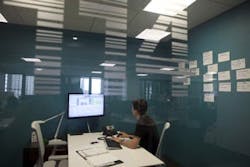This post originally appeared on Fast Company's website.
If you’ve been following news about workplace design in the popular media, you might believe that the open workplace has run its course.
The recent crescendo of negativity roughly started around the publication of Susan Cain’s book Quiet in 2012, which argued that in many corners of western society, including workplace design, extroversion has been fetishized at the expense of more solitary modes of working and learning. Since then articles questioning the effectiveness of open workplaces have appeared in Fast Company, Forbes, Fortune, and The New Yorker to name a few.
While there’s no shortage of bad workplaces (I’ve seen many) and no doubt that journalists are suffering in some of them, there are two big flaws with the now common claim that openness is bad.
The first flaw is that the claims are almost always based on individuals’ opinions about individual work. Arguably more important for an organization is the output of teams, departments and the organization itself, and unless the whole is no more than the sum of the parts in your organization, individual opinions about individual work won’t add up to the whole story.
More Posts on the Cannon Design Blog
As one study of computer-enabled collaboration showed in the 90’s, working interactively can at times be maddening compared to solitary work but still can collectively produce more and better outputs, sometimes to the surprise of the individuals involved.
Individual opinions about individual work are also problematic in that they tend to focus on immediate issues, like noise, while discounting indirect problems. My own research (the same research cited in The New Yorker article), actually showed that when people were asked to track time losses, challenges associated with interaction tended on average to be more significant than those associated with distractions; hence, fixing problems with interaction could produce bigger net benefits.
In fact, we found that people in relatively open environments tended to have dramatically better interaction patterns than those in relatively enclosed workplaces – like response times that were twice as fast – while those in relatively enclosed environments had only modestly fewer distractions (in-person distractions may very well have shifted to email distractions).
The bigger flaw, though, in recent criticisms of open workplaces is the underlying idea that there’s only one choice: open or enclosed. Work is invariably a combination of individual work, collaboration, coordination, creativity and other things, all of which can take a variety of forms, sometimes in just one person in one day.
As research done by CannonDesign with 14 organizations over the past year has shown, the average employee does want fewer distractions, but they also want 35% more frequent interactions within their teams; they want more energy and buzz in the workplace than less, but they also want the flexibility to escape to a quiet place from time to time. What they definitely don’t want is one space that’s just open or just enclosed.
Thankfully workplaces can be all combinations of open and enclosed. And openness (or closed-ness, if you prefer) is only one dimension of workplace design. How spaces are clustered and how people are enabled to work across a variety of different spaces are two other dimensions that can radically affect how people work.
Group spaces can, for example, be optimized to enhance productive distractions while minimizing the pointless ones, and individuals can be given a dozen types of spaces to choose from at any given moment rather than be limited to just one.
Is the open workplace over? That’s the wrong question. The question is how your organization works, how individuals and teams need to work, and how the full complexity of an organization can be supported by a multi-dimensional workplace that can be used in different ways over time.
What is over? Hopefully the artificial debate about open versus enclosed workplaces.
About the Author
David Craig is a Senior Vice President at CannonDesign in New York, where he leads the firm’s Workplace Strategy Practice globally.
About the Author
CannonDesign
CannonDesign’s Insights is a place for the global design firm to share thoughts and news related to their current efforts to help transform businesses, educational models and health paradigms. The firm engages diverse perspectives and expertise to deliver proven, innovative solutions to our most important partners, our clients. Our global network of more than a thousand professionals enable us to create design solutions to the greatest challenges facing our clients and society. Follow us on Facebook, Instagram, LinkedIn, and Twitter.
